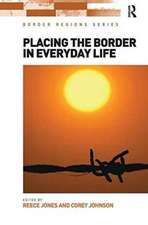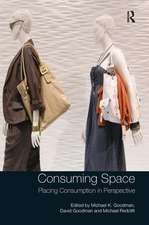Geo-Architecture and Landscape in China’s Geographic and Historic Context: Volume 1 Geo-Architecture Wandering in the Landscape
Autor Fang Wangen Limba Engleză Hardback – 2 mai 2016
This book is the first of a 4-volume book series. The series develops the innovative concept of “geo-architecture” by exploring the myriad influences of natural, human and historical factors upon architecture. These influences are considered in three categories, namely, interaction between architecture and nature, interactionbetween architecture and its human users and change in architecture over time--each category serves as a lens. Augmenting these lenses is the Time-Person-Place concept applied different geographic. The analysis ultimately focuses on two aspects: geographic influence on architecture and architectural response to geography. The over 1000 pictures of case architectures enriches the study with stunning and unique visual angles.
"This unprecedented work will be a unique and valuable contribution to the literature. Integrating as it does the disciplines of architecture, landscape architecture, and geography, Wang Fang’s voice is original, compelling, and will be much appreciated by English-speaking readers (and inside China, too, I can only imagine.)"
Stephen M Ervin Assistant Dean Graduate School of Design, Harvard University July 2nd, 2013
"One reason for why there would be interest is because her research would fill some significant gaps in the literature.
What is novel about Dr. Wang’s series is that she further extends this intellectual project of looking at Chinese architecture through Chinese eyes, by taking it one provocative step further."
Annette M. Kim Associate Professor Department of Urban Studies and Planning, M.I.T. July 1st, 2013
| Toate formatele și edițiile | Preț | Express |
|---|---|---|
| Paperback (4) | 386.00 lei 6-8 săpt. | |
| Springer Nature Singapore – 22 apr 2018 | 386.00 lei 6-8 săpt. | |
| Springer Nature Singapore – 15 iun 2018 | 387.38 lei 6-8 săpt. | |
| Springer Nature Singapore – 22 apr 2018 | 389.88 lei 6-8 săpt. | |
| Springer Nature Singapore – 27 mai 2018 | 390.25 lei 6-8 săpt. | |
| Hardback (4) | 393.35 lei 6-8 săpt. | |
| Springer Nature Singapore – 26 apr 2016 | 393.35 lei 6-8 săpt. | |
| Springer Nature Singapore – 24 aug 2016 | 394.87 lei 6-8 săpt. | |
| Springer Nature Singapore – 26 apr 2016 | 397.38 lei 6-8 săpt. | |
| Springer Nature Singapore – 2 mai 2016 | 403.91 lei 6-8 săpt. |
Preț: 403.91 lei
Nou
Puncte Express: 606
Preț estimativ în valută:
77.30€ • 80.60$ • 64.24£
77.30€ • 80.60$ • 64.24£
Carte tipărită la comandă
Livrare economică 21 martie-04 aprilie
Preluare comenzi: 021 569.72.76
Specificații
ISBN-13: 9789811004810
ISBN-10: 9811004811
Pagini: 296
Ilustrații: XXXI, 297 p. 338 illus., 260 illus. in color.
Dimensiuni: 155 x 235 x 23 mm
Greutate: 0.79 kg
Ediția:1st ed. 2016
Editura: Springer Nature Singapore
Colecția Springer
Locul publicării:Singapore, Singapore
ISBN-10: 9811004811
Pagini: 296
Ilustrații: XXXI, 297 p. 338 illus., 260 illus. in color.
Dimensiuni: 155 x 235 x 23 mm
Greutate: 0.79 kg
Ediția:1st ed. 2016
Editura: Springer Nature Singapore
Colecția Springer
Locul publicării:Singapore, Singapore
Cuprins
Part One Conversation and Sentiment.- Introduction.- "Conversation" Cases.- "Sentiment" Cases.- Part Two Halting and Advance.- Introduction.- "Halting" Cases.- "Advance" Cases.- Part Three Integration and Isolation.- Introduction.- "Integration"cases.- "Isolation" Cases.
Notă biografică
Fang WANG is a registered urban planner and an associate professor in College of Architecture and Landscape Architecture at Peking University. After receiving a Ph. D in Architectural Design and Theory from Tsinghua University, Wang completed her postdoctoral research in geography, with concentration in urban in College of Urban and Environmental Sciences at Peking University. From 2011 to 2012, as a visiting scholar, Ms. Wang joined in the teaching instruction for a studio at Graduate School of Design, Harvard University. She is a member of International Association for China Planning (IACP), the Chinese Academy of City Planning, the Chinese Geographical Society, and the Chinese Architectural Society. Her research introduces geographical philosophy, methods and techniques into urban planning and architectural design which have long been engineering-dominated fields. Her focus is also known as ‘Geo-design’ – research on the influence of geography upon urban planning and design and, reflexively, urban planning and design responses to geography. Wang is an primary author of more than 70 published articles which were published in some important journals, including Journal of Environmental Psychology、International Journal of Tourism Research、Managing Leisure, and she also has authored 2 books and translated a total of 8 books. She has piloted one of China Natural Science Foundation project and 6 provincial and ministry-level funding, and is also as principal partner in 3 other China National Foundation. In addition, she has won the 3rd prize of Excellent Academic Achievements by Chinese National Tourism Administration (2011) and the 2nd prize of Beijing Youth the Outstanding Scientific and Technological Thesis by Beijing Association for Science and Technology (2009).
Textul de pe ultima copertă
This book analyzes forms of architectures within the frame concept of geo-architecture, and looks into the interaction of architecture and its environment. It starts by discussing the collisions between architecture and geography, humanity, as well as other architectures and reflects on the ancient Chinese notion of emotional relief and expression through natural landscape. It then studies important transportation and scenic routes, like pavilions, towers, clan halls and villages within architectural systems. It also discusses the forms of geographic integration and isolation expressed through architecture, which reflects their historical and cultural context. This book is the first of a 4-volume book series. The series develops the innovative concept of “geo-architecture” by exploring the myriad influences of natural, human and historical factors upon architecture. These influences are considered in three categories, namely, interaction between architecture and nature, interaction between architecture and its human users and change in architecture over time--each category serves as a lens. Augmenting these lenses is the Time-Person-Place concept applied different geographic. The analysis ultimately focuses on two aspects: geographic influence on architecture and architectural response to geography. The over 1000 pictures of case architectures enriches the study with stunning and unique visual angles.
"This unprecedented work will be a unique and valuable contribution to the literature. Integrating as it does the disciplines of architecture, landscape architecture, and geography, Wang Fang’s voice is original, compelling, and will be much appreciated by English-speaking readers (and inside China, too, I can only imagine.)"
Stephen M Ervin Assistant Dean Graduate School of Design, Harvard University July 2nd, 2013
"One reason for why there would be interest is because her research would fill some significant gaps in the literature.
What is novel about Dr. Wang’s series is that she further extends this intellectual project of looking at Chinese architecture through Chinese eyes, by taking it one provocative step further."
Annette M. Kim Associate Professor Department of Urban Studies and Planning, M.I.T. July 1st, 2013
Caracteristici
The first book to systematically elaborate and formulate the idea of geo-architecture Features case studies of traditional Chinese architectures with over 200 splendid pictures Studies the form of architectures and their relationship with surrounding natural environment Includes supplementary material: sn.pub/extras



























